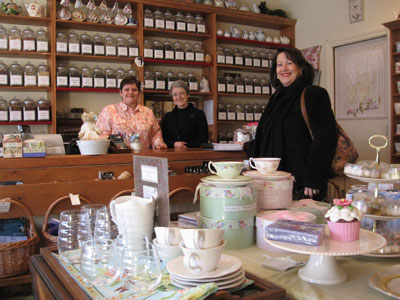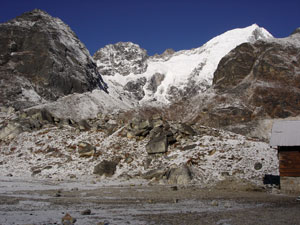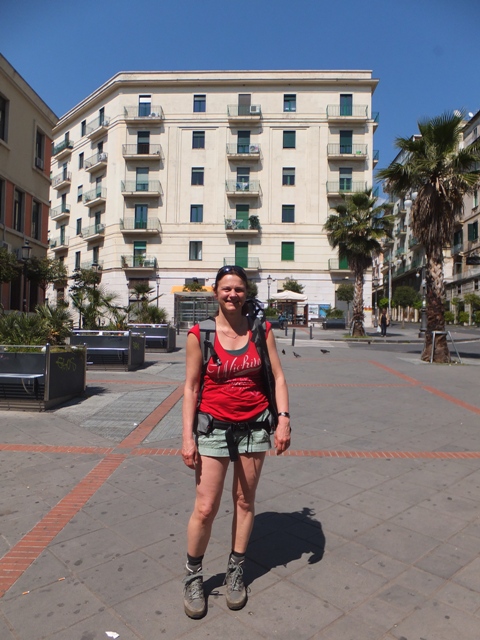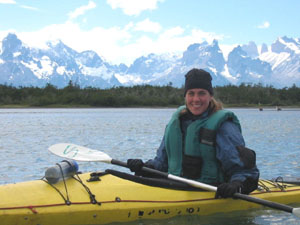Every Canadian neighbourhood is officially represented at three different levels: the municipal, provincial and federal levels. As far as the Beach neighbourhood is concerned I had already had a chance to get to know the municipal representative, City Councillor and Deputy Mayor Sandra Bussin, and the Provincial Member of Parliament, Michael Prue. I was really looking forward to meeting the Federal Member of Parliament for the Beaches / East York Riding: Maria Minna.
Maria and I met in a small local Chinese restaurant called the Honeybee. This restaurant, located right across from the Beaches Library, has been around forever, and on this Saturday afternoon we sat down for a nice late lunch. Maria started to tell me about her background and disclosed that she was born in a small town called Pofi not far from Rome. She spent the first nine years of her life in Italy and grew up on a farm. She refers to her childhood as privileged, since she grew up with holistic food, such as home-grown grapes, fruits and cherries. Her parents were also raising chicken, rabbits and pigs for their family’s needs. Maria used to go to school for a half day, and would do chores in the afternoon. Her parents would take wheat to the mill and come back with bags of whole wheat flour. Even after many years in Canada, Maria’s mother would never buy canned or frozen vegetables.
In 1957 Maria arrived at 9 years of age at Pier 21 in Halifax together with her mother and siblings. None of them spoke any English. Her father had already been in Canada. A little anecdote from Maria’s arrival in Canada illustrates the initial culture shock: on the train to Toronto her mother wanted to buy some bread for her children, but was only offered white Wonderbread type of bread. Her mom had a look at the loaf and said “This is not bread.” Until the end of her mother’s days, white bread was only good for toast.

Maria at the Honey-Bee Chinese Restaurant
After two days and nights on the train through the snow her mother was wondering where her father had taken them. Maria admitted that the first few years were tough: she did not speak any English, and had to leave her friends in Italy behind. Her dog was also left behind and died of heart break. At the beginning she had difficulty in school because she did not speak any English. She was put a year back in school, had to learn only basic math and had to write in a pencil again. In Italy she had already been writing with a fountain pen. In grade four she finally skipped a grade and recouped one year. Her mother was illiterate and worked in a factory while her father worked in construction. This was a time when there were very few health and safety standards for workers, particularly immigrant workers. Italian children were regularly streamed into vocational schools with lower academic standards. Even as recently as 1987 only 7 % of Italian children went to university.
Maria enlightened me a bit more about the fate of Italian immigrants years ago. During the war many Italian-Canadian men were arrested and detained at the Petawawa military camp. Although they were Canadian citizens their property was often sold for one or two dollars. Italians were declared enemy aliens and fingerprinted. When Maria arrived, some of the earlier Italian immigrants did not want to deal with the new arrivals; they wanted to blend into Canadian society and not get noticed. Italian men and women were often exploited, and their health was put in danger as they often had to work in inhumane conditions.
When the Toronto subway was built there was a major accident at an area called Hogs Hollow, just south of York Mills Road. Maria explained that five Italian men were buried alive under the Don River. The city person in charge had no idea of construction. Many Italian immigrants worked in jobs that required heavy physical labour and were at a high risk of injury. When they experienced an accident, Workers Compensation would treat them like a piece of meat, and compensate them according to the “meat chart” (they would not receive benefits based on the severity of their disability). Many men suffered a broken back and would be diagnosed with “degenerated disk disease”, a diagnosis that would minimize their claim entitlements, and they were simply encouraged to get a light job.
A tough immigrant story unfolded during Maria’s first few years in Canada: she went to a Catholic Elementary school and her brother had a learning disability, and started to work at age 16. Maria on the other hand took a commercial course at age 18, having worked part time through high school, So Maria started to work as a secretary and helped to pay for her sisters’ education and even paid off one of her parent’s mortgages on the family home.

Dropping by at a store called Latitude for Living
Maria added that she has always had to carry several responsibilities at the same time. Ever since her parents came to Canada Maria had to become their interpreter and the administrator of family affairs once she had command of the English language. She also helped her parents and other immigrant neighbours with their income tax returns and generally managed the family’s affairs. Up until the recent deaths of both her parents, Maria was overseeing their responsibilities, and when she was giving her father’s eulogy in February of 2006 she realized that now her job was actually done. This funeral was going to be the last responsibility that she had to handle on behalf of her parents. From age ten onwards Maria had been shouldering many family responsibilities including starting dinner, making lunch for her dad and brother, stripping floors and doing housework. In retrospect she says that she never really had a childhood; she does not recall ever really having play time as a child in Canada.
To earn more money Maria also did modeling for three years from age 19 to 22. She quit her secretary job since she realized that modeling was more lucrative. This helped her pay her parents’ mortgage off more quickly and allowed her to save money for university. She could achieve these financial goals much faster as a model.
At age 24 she finally started her academic studies: she enrolled in a sociology program at the University of Toronto in 1972, so began her fight for social justice. Early on she got involved in municipal issues. She noticed that the Annex neighbourhood had more infrastructure funding from the municipal government while her neighbourhood in the west end near Ossington and Christie, a mostly immigrant neighbourhood, received very few municipal projects. Maria explained that the people in her neighbourhood never asked for any money to get their streets fixed; they were actually under the impression that their taxes would go up if they asked for more resources from the city, so they never even tried.
Always interested in social justice issues, Maria got involved as a volunteer and community activist. She felt that immigrant communities were being treated differently and action was needed. In 1974 she was offered to work on a special project at a local organization named COSTI Immigrant Services, which today is a community-based multicultural agency providing employment, educational, settlement and social services to all immigrant communities, new Canadians and individuals in need of assistance.

A visit to Kids at Home on Queen Street East
More than 30 years ago Maria was hired as part of a summer program to establish a women’s centre specifically targeted at Italian women in the Jane and Finch area. A federal election was being run right around that time, and Maria got a call from Paul Hellyer, a Conservative politician who was formerly a Liberal, to help him with the federal election. Maria did not want to work with this individual and said “If I do this kind of work I’ll do it for free for a Liberal candidate”. So she called Aideen Nicholson, a Liberal candidate, but did not get a call back. A few days later Aideen showed up at her door and said “we need you”.
Maria was helping former Prime Minister Trudeau with his campaign when he was coming through local Toronto neighbourhoods to canvass door to door. She would go ahead of him and get people’s names and introduce them to the Prime Minister. At the end of the election she accepted a job with the new Member of Parliament, Aideen Nicholson. This was right about the time when she was headed into her third year at U of T.
Her job was to look after people’s problems, help them with immigration issues and Workers Compensation. Maria got involved with the Liberals and turned out to be a good campaign manager. After graduating from her sociology degree Maria started consulting in public policy and management. She continued volunteering for COSTI and in 1981 she was elected as President of the Board of Directors.
From 1974 to 1992 Maria volunteered with COSTI Immigrant Services and was the President of COSTI’s Board of Directors for 11.5 years. Maria’s interest in multicultural issues has always been strong, and Maria lobbied hard for the Canada Multiculturalism Act, a piece of legislation for the preservation and enhancement of multiculturalism in Canada.
With the help of the Women’s Legal Education Fund Maria helped launch a Charter challenge on behalf of immigrant women. They were not given English as a Second Language training simply because they were women, and the expectation was that they were going to take on only menial jobs anyways. Maria added that in effect these policies were shutting women up. As a result she launched a challenge under the Canadian Charter of Rights in 1986 for group discrimination and won. From that point forward immigrant women became eligible for English as a Second Language training programs. Maria fought numerous wars on behalf of immigrants and refers to herself as a “shit disturber”.

Maria with Barbara DeAngelis and Tamsin Salter at Pippins Tea Company Inc.




